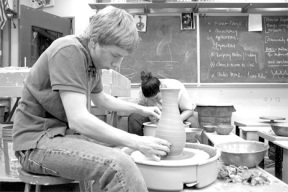Throwing, handbuilding, slipcasting, turning, jiggering, jolleying, centering, fettling, bulging, fluting, faceting, incising and trimming.
No, these words do not describe what one does on an overly festive party boat. They’re descriptions of what many of the advanced and beginner ceramics students of Rich Connover’s ceramics studio at South Whidbey High School have been doing for months now.
The ceramic pieces produced during those fruitful months will be on display in a show entitled “Great Bowls of Fire,” showing Saturday, June 2 through Monday, June 4 at the Front Room gallery in the Bayview Cash Store.
The 28 beginner and advanced student artists will be on hand for an artists’ reception from 1 to 4 p.m. Saturday,
June 2 to open the annual show.
Pottery can be produced in three basic forming traditions: handwork, wheel work and slipcasting.
It’s very common for wheel-worked pieces to be finished by handwork techniques. Slipcast pieces tend not to be, as the method uses a mold for mass-produced pieces that are required to be exactly the same, such as dinnerware.
The students’ work tends to use the handwork methods, also called “handbuilding,” and is the most primitive and the most individualized technique. No two pieces of handwork will be exactly the same, which gives the potters the chance to use their imaginations to create one-of-a-kind works of art.
Clark Sarbaugh is one of the student artists who will show his work. He said Connover has been instrumental in allowing the students to find and develop their own style.
“He lets the work be about the process,” said Sarbaugh.
Fellow ceramic artist Chelsea McHugh agreed.
“Mr. Connover showed us how to be patient with the work; how to focus just on that and to not think about anything else,” McHugh said.
“It’s like a meditation,” added Hailey Johnson, another artist in the show.
“I don’t think about anything else when I’m working in that studio.”
Students said the ceramic studio is a completely different environment from every other room in the school and lends itself to a unique energy that allows them to focus on their art. Connover rid the room of fluorescent lighting and brought in his own lights, which students said changes the feel of the room and puts them in the mood to create.
Another important feature of the class is that all the students, beginning and advanced, are expected to collaborate with each other while working in the studio.
Teamwork also played a part in put together the art show; students said it was also a group effort and that they came together to decide how the show would be presented, with a little guidance from their teacher.
With “Great Bowls of Fire,” the students said they were looking forward to showing their work and perhaps inspiring other people, perhaps younger students, with their art.
“We want the community to see the art and to know what we’ve done,” said student ceramicist Richie Alexander.



